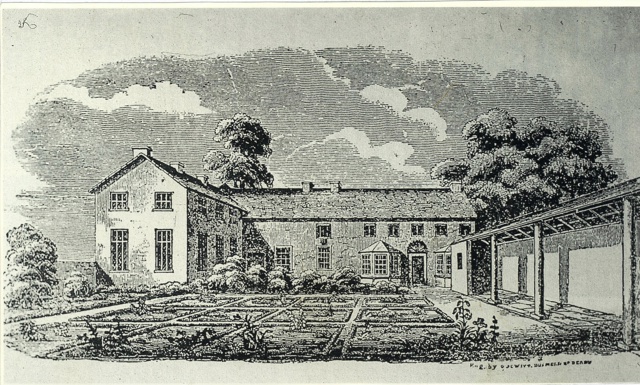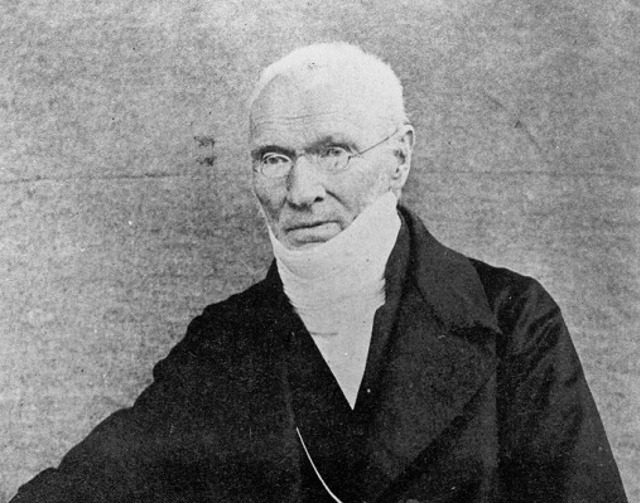The Brontë Sisters and Brontë School House
Although most famous for the Brontë sisters having attended school here in 1824-25, the original house was actually built in approximately 1770 for Christopher Picard, a gentleman, and his family.
Two generations of the Picards resided at the property before in 1823 the house was purchased by Rev. William Carus Wilson to establish the Clergy Daughters’ School (attended by Charlotte and Emily Brontë).
Rev. William Carus Wilson was a wealthy evangelical clergyman and landowner who was a firm believer in the value of education. He was well aware that the income of the poorer clergy was insufficient to allow them to properly educate their daughters (at the time priority would always have been given to providing any sons with an education); he therefore resolved to establish a school for girls that would be affordable to the poorest of the clergy.
The stated purpose of the school was to provide:
“the intellectual and religious improvement of the pupils and to give that plain and useful education which may fit them to return with respectability and advantage to their homes or to maintain themselves in the different stations to which providence may call them”.

Rev. William Carus Wilson
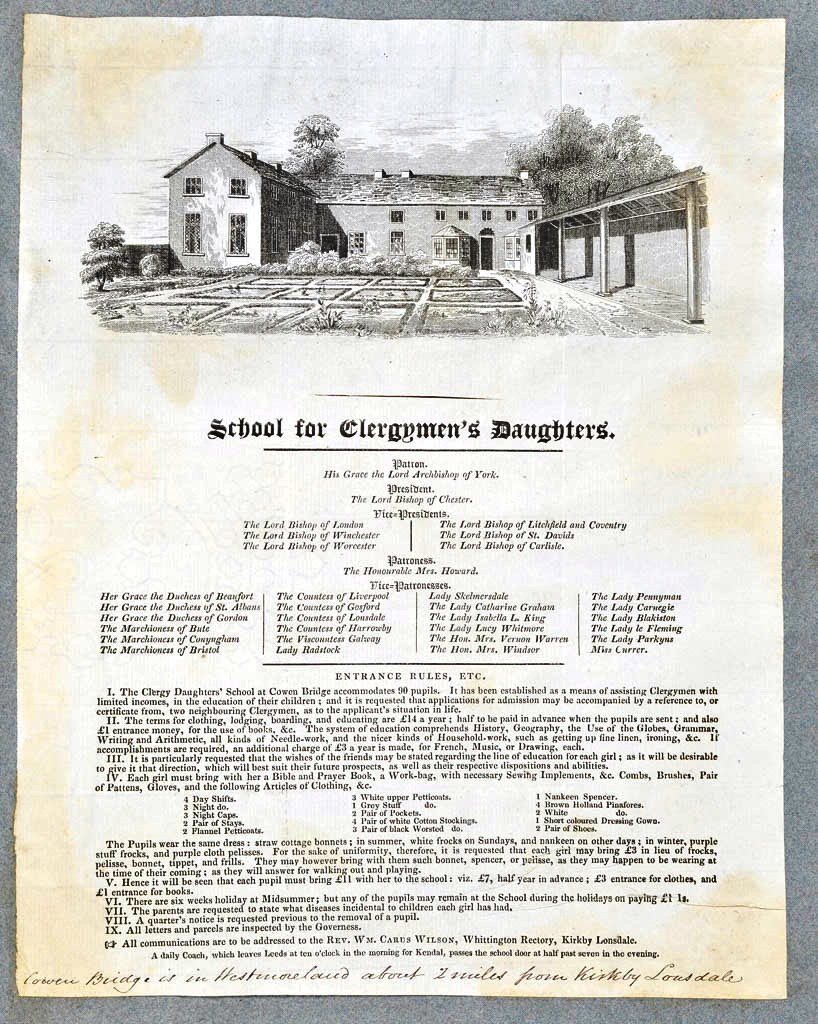
The syllabus was to include history, geography, grammar, writing, arithmetic, needlework and “the nicer kinds of household work” as well as French, drawing and music as extras.
The set-up of the school was funded by not only Mr. Wilson but also a number of his friends and others who believed in the importance of education for girls. One of the benefactors was William Wilberforce: the MP and slavery abolitionist.
Mr. Wilson purchased a property in Cowan Bridge [that which is now Nos.1-3 Brontë Cottages] on the Kendal to Leeds turnpike road for the purposes of establishing the school. He added a wing to the property [perpendicular to what is now No.3 Brontë Cottages] to house the dormitories (upstairs) and the schoolroom (downstairs) and a verandah opposite to allow outdoor exercise even when the weather was bad. The dining room, kitchen, superintendent’s [head’s] lodgings and teachers quarters were all housed within the original part of the property. The school’s garden was divided into many small plots each of which was to be cultivated by one of the pupils. On the opposite side of the road was a cottage [this property was compulsorily purchased and demolished in the 1960s when the road was widened] which, in the early days, was often used as a sanatorium.
The school first opened with six teachers, two under-teachers and six servants but their numbers soon increased to eight teachers, two under-teachers and seven servants. Additionally a music teacher came to the school regularly. The first superintendent was Miss Evans, described as a “great dear” by an ex-pupil and probably on whom Charlotte based the character of Miss Temple in Jane Eyre. Unfortunately the first cook/housekeeper at the school, who was incumbent during the Brontës attendance, was dirty and wasteful but the teachers were fearful of complaining of such to Mr. Wilson as she had long been known to the Wilson family; she was eventually replaced by a housekeeper who by all accounts did an excellent job and remained at the school for twenty years.
The school fees paid by parents/guardians of £14 per year (only half that of comparable schools) were insufficient to cover the running costs and were subsidised by donations and subscriptions made by not only Mr. Wilson and his friends and neighbours but also some of the most eminent people in the country. (Mr. Wilson was known to be a committed educationalist and had many influential contacts within both the local area and London’s philanthropic circles).
On 30th January 1824 the first pupils, aged from 6 to 18 years, were enrolled. The level of attainment upon entry to the school was generally recorded as being very low with the majority of girls being initially described as “vile readers” or “reading miserably” with very few capable of ciphering (arithmetic).
It was only six months later that Patrick Brontë himself brought his two oldest daughters Maria and Elizabeth Brontë to the school where they were registered as the 17th and 18th pupils on 21st July 1824. Patrick stayed overnight at the school and dined with the children; he returned home evidently satisfied with what he saw.
Charlotte Brontë followed on 10th August 1824 (30th pupil) and Emily on 26th November 1824 (44th pupil). All four of the Brontë sisters had suffered whooping cough immediately prior to attending the Cowan Bridge school and it may be their differing times of recovery which precluded them from all travelling to the school together.
Charlotte’s entry (aged 8) in the school register [The original register is held in Kendal Archives] recorded her attainments as follows: “Reads tolerably. Writes indifferently. Ciphers a little and works [needlework] neatly. Knows nothing of grammar, geography, history or accomplishments [French, music, drawing].” Miss Evans, the Superintendent, did however describe Charlotte as being “altogether clever of her age, but knowing nothing systematically”.
Emily’s entry (aged 6) recorded her attainments as: “Works a little. Reads very prettily”. It is possible of course that attainments upon entry to the school were underplayed in order to show more progress upon leaving the school!
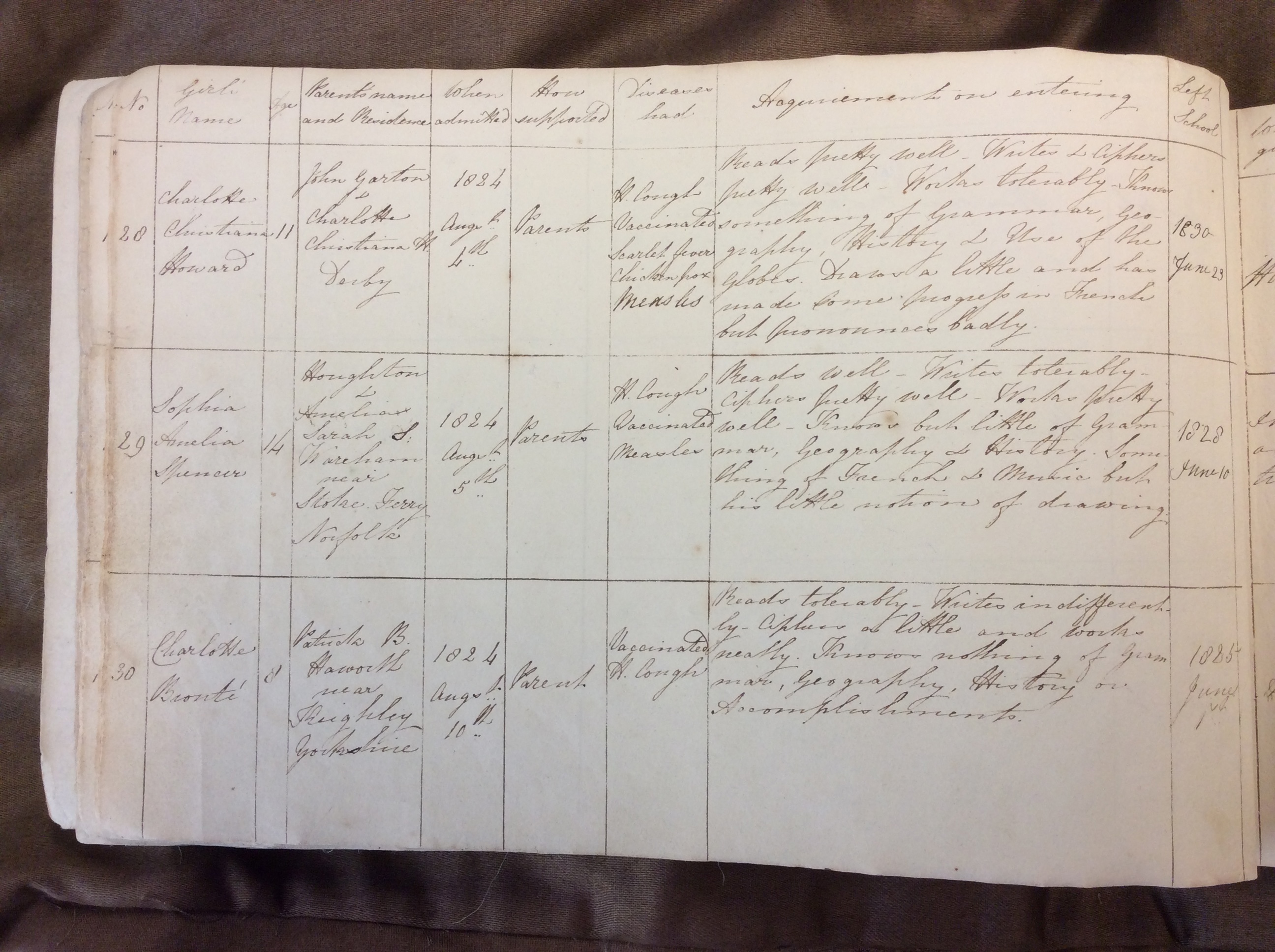
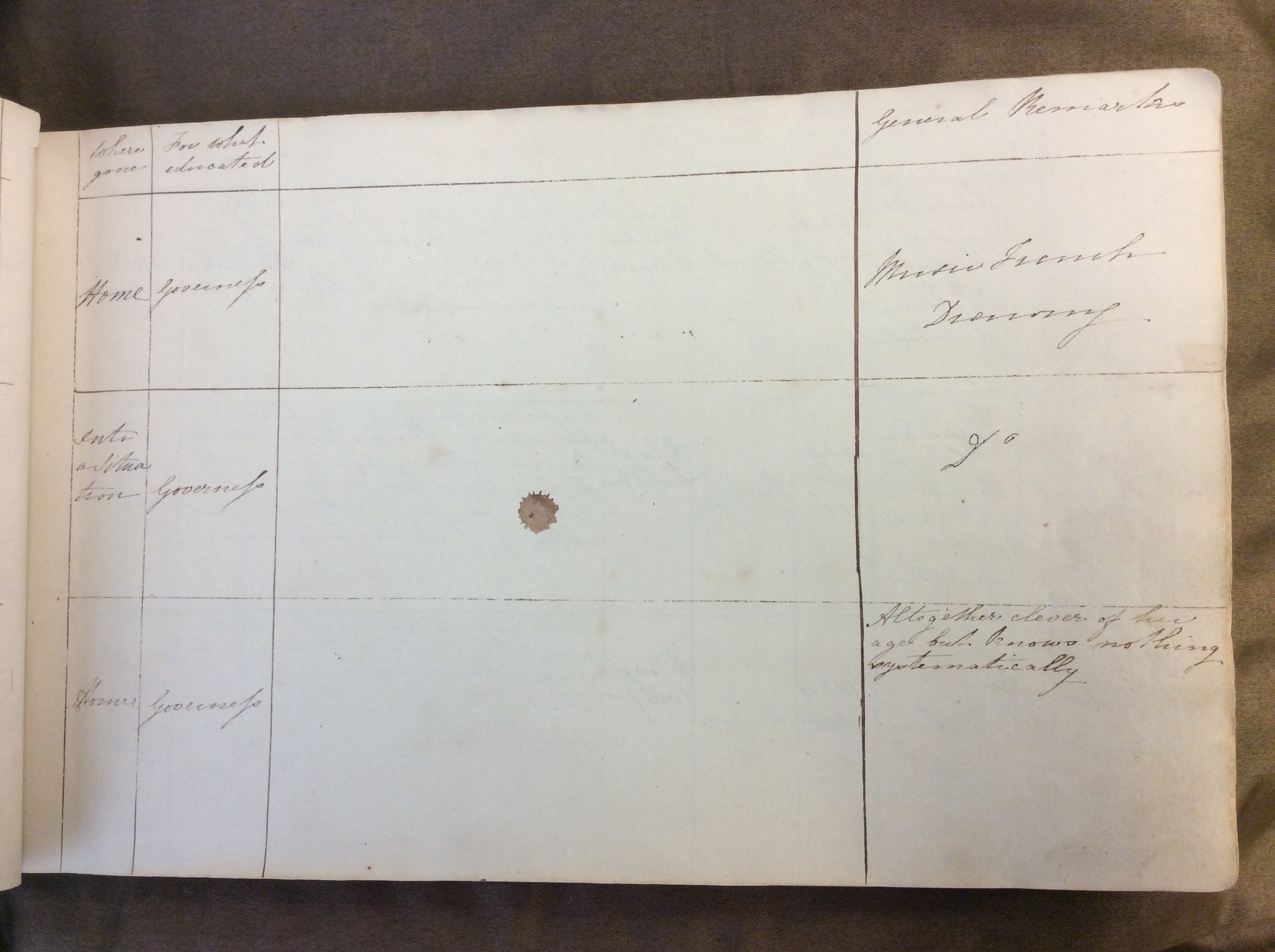
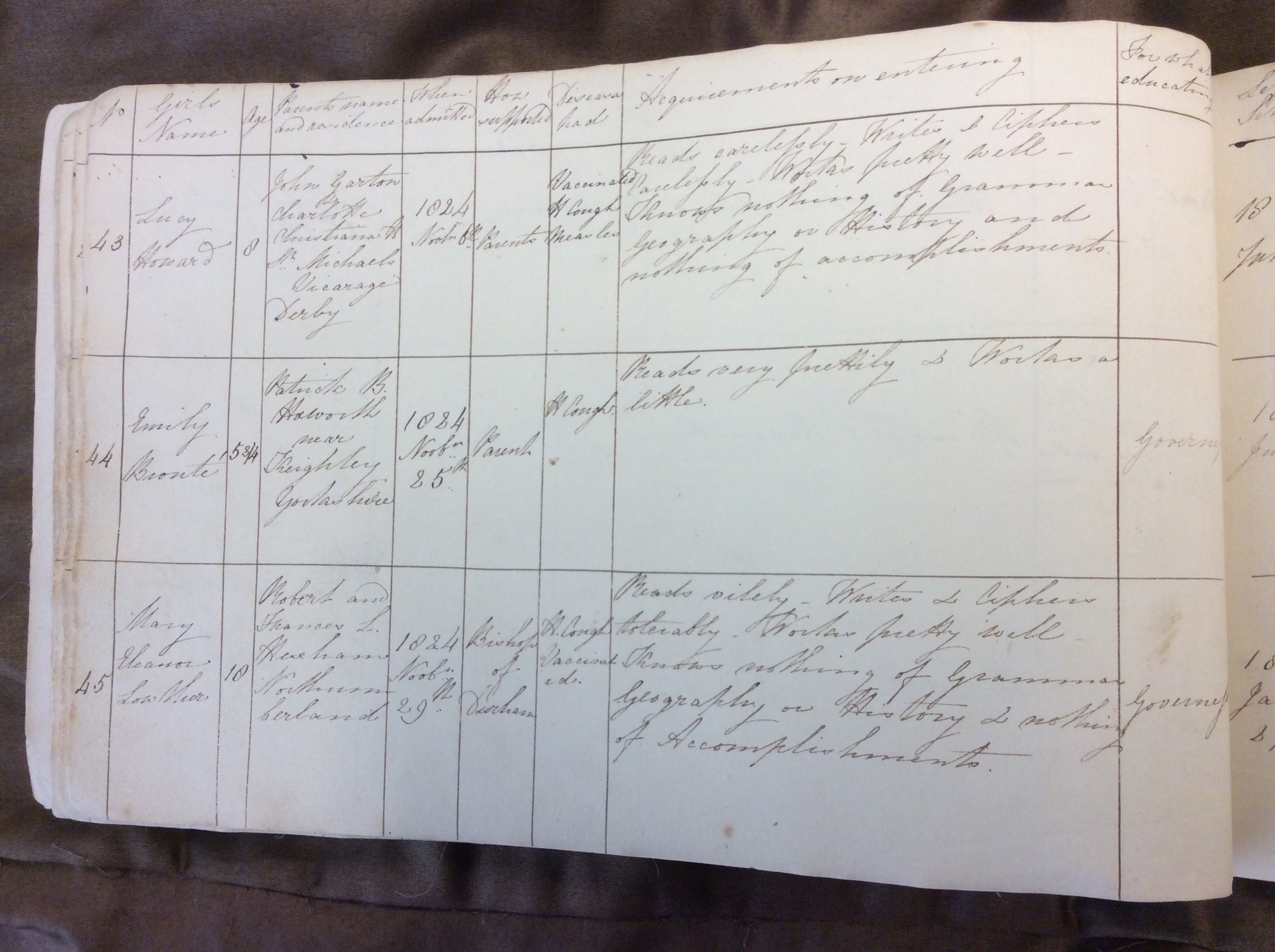


The school uniform worn over the underlayers of shift [plain undergarment], stays [corset] and petticoat was:
in winter: a stuff [woollen] purple dress with purple pelisse [cloak] and black woollen stockings and if going outside pattens [overshoes] and a plain straw cottage bonnet;
in summer: a nankeen [buff-coloured cotton] dress with short sleeves and high neck, white cotton stockings and sturdy shoes, with straw cottage bonnet trimmed with green calico and perhaps a nankeen spencer [short fitted jacket] when out.
On Sundays for church in summer they wore white dresses with short sleeves and low necks with white bonnets trimmed with purple ribbon, white muslin frills and long white cotton gloves. In addition whilst at the school the girls would wear brown holland [linen] pinafores on week-days and white on Sundays.
A day in the life of a pupil...
- 6am A bell would wake the girls and in winter they would have to break the ice on the water before they could wash!
- 7-8am Prayers and a bible reading in the schoolroom followed by repetition of texts, hymns and lessons learnt by rote the evening before.
- 8am Breakfast, consisting of porridge - notoriously often burnt by the first cook! - followed by free time to talk/play until 9am.
- 9-12 midday Lessons. Oatcake was provided mid-morning.
- 12-1pm Recreation in the garden or under the verandah, or a walk or run about on the fells. Recreational equipment was provided: skipping ropes, rods & hoops, rackets & shuttlecocks, boats on rockers. It should be noted that story books eg fairytales were not allowed as they were considered wicked! In lieu Mr.Wilsons own publications: "Child's First Tales" and his monthly: "The Children's Friend" containing prayers, religious poetry & short bible tales encouraging piousness/ advising of the evils of sinning (often ending in death-bed scenes!) were provided.
- 1pm Dinner: main meal of the day where pudding was always served first followed by meat & potatoes plus vegetables.
The menu for many years was:
- Monday: Baked rice & a “pie of odds and ends”
- Tuesday: Treacle pudding & hot roast meat
- Wednesday: Suet pudding & hotch potch
- Thursday: Rice and treacle & hot roast meat
- Friday: Baked rice pudding & hot pot or pie
- Saturday: Hot boiled beef with milk pudding and potatoes
- Sunday: Baked rice pudding & cold boiled beef
- 2-5pm Lessons in the schoolroom.
- 5pm Coffee or milk and bread & butter followed by recreation. On Sundays the younger children had milk and bread with a spoonful of treacle; the older children had weak tea [remember tea then was still considered a luxury] with bread & butter.
- 7-8pm Study (older girls only), glass of water & piece of oatcake, prayers and then bed.
- On Thursday and Saturday the girls had half days with much of Saturdays’ free time being spent in tasks such as mending clothes.
- On Sundays the older girls would walk two miles to Tunstall church, where Mr.Wilson preached, to attend both morning and afternoon services, they would take a cold packed lunch to eat between services; you can imagine the torment on a cold wet winter’s day sitting in damp clothing in an unheated church! The younger girls (probably including both Brontës) attended Leck church (only half a mile away). The year after the Brontës left, Sunday services for all girls transferred to Leck church. The girls had to pay strict attention to Sunday sermons as every Monday they had to write a full account of them and no note taking was allowed!
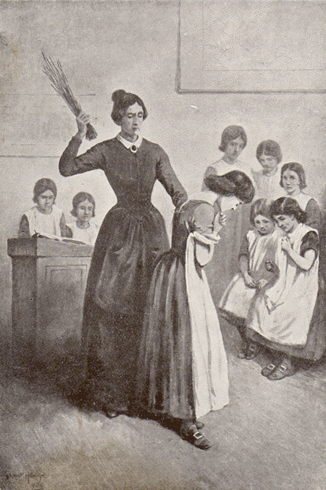

Discipline, personal cleanliness and neatness at the school were strictly maintained and offenders received punishments ranging from standing on a stool, or wearing a badge declaring the offence, to birching [beating with a bundle of twigs]. Such punishments were however common to other schools at the time.
In summer there was six weeks holiday during which the girls could return home or stay on at the school (for a £1 fee). Those who stayed went to Silverdale for 2-3 weeks, staying in lodgings or in a house rented by Mr.Wilson. It seems that this was a real treat for the girls who looked forward to going to Silverdale in the school shandries (carts). Mr.Wilson would organise trips from Silverdale into what we now know as the Lake District or to places of interest such as Levens Hall Gardens.
At Christmas the girls did not return home as there were just a few days break in lessons.
Several epidemics, particularly typhus (spread by lice, fleas or mites hence probably brought into the school from outside contact with someone maybe from the village), hit the school as well as there being the ever present threat of consumption/TB (which afflicted both Maria and Elizabeth Brontë and indeed Emily and Anne a number of years later). Such epidemics were not unusual for the time where large numbers of people were living in close proximity, when the importance of good sanitation/hygiene was not yet fully understood and when of course antibiotics were not available for treatment. Past pupils have however told of the great care and solicitation administered during such epidemics and when the doctor advised removing the healthy girls from the school during the epidemic that hit whilst the Brontës were there, Mr. Wilson sent them (including Charlotte and Emily) to his summer home in Silverdale. That very day though Elizabeth was deemed to be so ill that she was escorted back to Haworth by a servant. It is probable that Patrick was not forewarned of Elizabeth’s return and upon seeing how frail she looked immediately went to bring home both Charlotte and Emily who then never returned to the Clergy Daughters’ School.
Maria returned to Haworth 14th February 1825, died 6th May 1825;
Elizabeth returned to Haworth 31st May 1825, died 13th June 1825;
Charlotte and Emily were removed from the school 1st June 1825.
The two fever graves for three of the girls who died at the school can be found in Leck churchyard.
In spite of the aforementioned the school proved to be very popular and by 1827 there were 75 pupils (with 20 more on the waiting list) registered at the school drawn from far and wide: not only England, Wales and Ireland but as far away as Sierra Leone, the West Indies and New South Wales (presumably daughters of missionaries).
In 1833 the need for larger premises resulted in the Clergy Daughters’ School being relocated to purpose-built premises in Casterton on a two acre plot of land which provided plenty of space for gardens and a playground; a chapel was also built at the bottom of the garden to enable regular, easy church attendance.
In 1847 Charlotte Brontë’s Jane Eyre was published. The ‘Lowood Institution’ in chapters 5 – 10 was largely based upon her recollections of the time she spent at the Clergy Daughters’ School in Cowan Bridge.
After the school was moved to Casterton, the left-hand wing of the building was converted to a bobbin-mill (Lancashire Textile Mill 1150) where wooden reels were made out of the alders which grew around Cowan Bridge. In the early hours of Tuesday morning 6th March 1838, however, there was a fire in the bobbin mill which destroyed the left-hand wing of the building and it was only down to the early discovery of the fire and the subsequent efforts of the mill workers and neighbours that the whole of the clergy daughters school was not lost to the fire.
In 1843 The property was divided into five tenements.
c.1851 A beerhouse named Cow Inn was set up in the cottage nearest the road. (In c.1830 the sale of beer was deregulated thereby enabling the opening of innumerable beer/alehouses. A licence was not required to sell beer; these establishments could not however sell wine or spirits. At one point it is believed that almost one in three houses in the country were selling beer!)
1857 the property was restored to two cottages
1874 the covered verandah of the Clergy Daughters’ School was removed when the current “old” bridge (now pedestrianised) over Leck Beck was built.
c.1900 the property was divided into three cottages.
Researched & compiled by Sandra Barker; any questions please contact me on e-mail: bronteschoolhouse@btinternet.com or mob: +44(0)7702 074047
